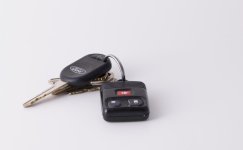I went with something like that in the beginning, with foamies,

but I changed my ways soon. There is much "he-man macho" content about this on the web, where More Size Is Never Enough.

But if the direct flash overpowers the ceiling bounce, it just becomes direct flash again... a
small direct flash. Close macro distances are one thing (size becomes easy, and this becomes very desirable - a six inch light at six inches is a very large light), but at ten feet, the light is just from a small direct flash again. IOW, simply still a very small direct light.
The purpose of using bounce is to NOT use direct frontal flash. We cannot aim it, not like an umbrella, but off camera Not frontal creates the pleasing shadows that model the shape and curves (not deer in the headlights). The large ceiling makes it be a very large diffused light, making the shadows only be smooth gradient shaded tones, natural, very pleasing.
If we pay close attention to what we can see is actually happening, the little pullout bounce card puts out a surprising amount of light, possibly even too much (we don't have to pull it out all the way). It's major role is to provide sparkling catchlights in the eyes, to add vitality and liveliness. A little goes a long way. The major light should be the large soft diffused ceiling reflection. If the direct light covers all of that up, what's left? (at ten feet, only a small direct flash is left).
I think it is always very instructive to put the camera on a fixed tripod, and test with and without the addons, to very carefully examine the light and know exactly what actually happens, the differences and shadows we can actually see.
The domes for example... used as direct flash (not bounce), any notion of actual diffusion is mostly imaginary wishful thinking, certainly at any normal distance past about three feet. Just too small, they can only scatter light outwards (entirely missing the subject), instead of being a large light that directs wider light back to the subject from different angles to provide Soft. We like to pretend the sides of the dome provide reflected light from all the room walls, but a quick thought about inverse square law rules that out, unless in a very small room. We should examine results actually looking to see what happens. If we can't see it, it didn't happen (except the hardest factor is to learn to "see" what we are looking at). So umbrella (large) easily beats a dome (small). Both do increase the flash power required, which red cast becomes a slight warming tone, unless corrected. Beginners may imagine the warm tone is lighting.
For bounce, the only purpose of dome or pullout card is the forward spill directly to the subject (for eye catchlights and in some degree fill), but IMO, the pull out card does that better (less, which is more, and it can be adjusted).








